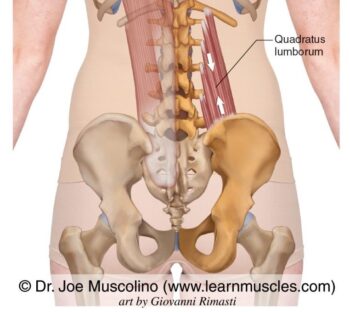
The quadratus lumborum, or QL for short, is a deep abdominal muscle, responsible for forming the posterior abdominal wall. It originates on the posterior iliac crest (back of the pelvic bones) and inserts into the transverse processes (the bones that protrude sideways off of each of the vertebrae in your spine) of the L1-L5 lumbar vertebrae and the 12th rib.
One of the primary actions of this muscle is to elevate the hip in a sideways motion (moving hip towards the ear). It plays a key role in walking, facilitating the rotational movement between the pelvis and spine. It also works in back extension and serves as an accessory muscle for respiration.
Tightness in the QL can cause the lower back to overarch (lumbar lordosis) and push the pelvic bowl forward into an anterior tilt. The QL often compensates for weak gluteal muscles, causing an excessive hip-hiking motion when walking.
Even though the QL is considered an abdominal muscle, massage therapists access this muscle from the back body, working our way under the erector spinae muscles to reach the lateral edge of the QL. When a client comes in with lower back pain, the QL is definitely one of the areas I check in with to get this muscle loosened up and moving more freely.
* Picture of quadratus lumborum muscle courtesy of Dr. Joe Muscolino.
